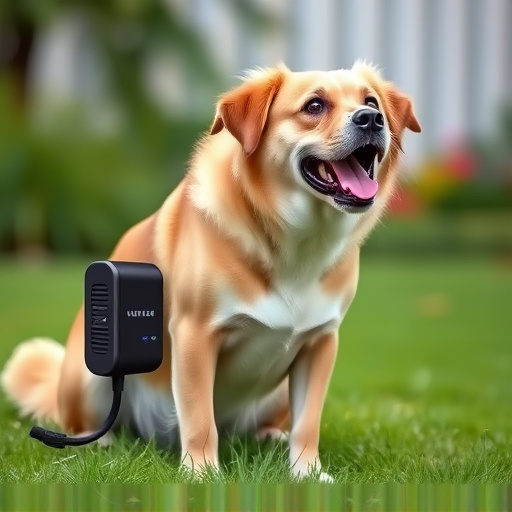Ultrasonic dog repellents, a versatile solution for pet owners, emit inaudible high-frequency sound waves activated by motion sensors upon detecting dogs. Their effectiveness lies in adjusting training levels based on dog breed and hearing sensitivity, ensuring minimal disruption for smaller dogs while maintaining control over larger breeds. By starting with lower settings and gradually increasing, owners can teach their dogs to avoid specific areas, enhancing safety during walks. These repellents are most successful when used alongside positive reinforcement techniques, making them a valuable tool for pet training and well-being.
Stay safe and keep your walks stress-free with ultrasonic dog repellents—a revolutionary tool for pet owners. This article guides you through mastering these devices, ensuring a harmonious coexistence with nearby canine companions. From understanding their science to finding the right training levels, we explore practical tips for effective integration into daily routines. Learn how to use these repellents safely and responsibly, making your walks more enjoyable without compromising your peace of mind or the comfort of local dogs.
- Understanding Ultrasonic Dog Repellents: How They Work
- Adjusting Repellent Training Levels for Optimal Effectiveness
- Integrating Sonic Repellents into Daily Walking Routines
- Safety Considerations and Best Practices for Using Ultrasonic Dog Repellents
Understanding Ultrasonic Dog Repellents: How They Work
Ultrasonic dog repellents are a popular choice for pet owners looking to keep their four-legged friends away from certain areas during walks. These devices emit high-frequency sound waves that are inaudible to humans but can be unpleasant or even painful for dogs. The technology is based on the principle of adjusting sonic repellent training levels, where the device’s intensity and frequency can be modified to suit different situations and dog sensitivities.
When a dog approaches the repellent, it detects the animal’s presence through motion sensors and immediately activates the ultrasonic sound. By adjusting the training levels, owners can set the sensitivity and range of the device, ensuring that smaller dogs or those with more sensitive hearing are not triggered unnecessarily while still providing effective protection for larger breeds. This versatility makes ultrasonic repellents a flexible solution for various environments, from urban parks to suburban backyards.
Adjusting Repellent Training Levels for Optimal Effectiveness
When using an ultrasonic dog repellent, adjusting the training levels is key to achieving optimal effectiveness. These devices emit high-frequency sound waves that are inaudible to humans but irritating to dogs, causing them to avoid certain areas. However, not all environments or situations require the same intensity level. Adjusting the settings allows you to tailor the repellant’s output according to factors like outdoor noise levels, proximity to neighbors, and your dog’s sensitivity.
Starting at a lower training level is recommended, as it’s less disruptive to both your dog’s hearing and nearby residents. Gradually increasing the level once you observe consistent aversion behavior in your dog is a more targeted approach. It’s important to be patient during this process, allowing your dog time to learn and adapt. Regularly monitoring their response will ensure you find the perfect balance between effectiveness and comfort.
Integrating Sonic Repellents into Daily Walking Routines
Integrating sonic repellents into daily walking routines can significantly enhance safety for both dogs and their owners. These devices emit high-frequency sound waves that are unpleasant to animals, encouraging them to avoid specific areas. By adjusting the training levels of these repellents, you can teach your dog to stay clear of potentially dangerous paths or locations. Start with a lower frequency setting, allowing your pet to become accustomed to the sound without discomfort. Gradually increase the intensity as your dog demonstrates better understanding and compliance.
Regular practice during walks is key to effective training. Different environments may require varying adjustments in settings; for instance, dense forests or urban areas might necessitate higher frequencies to penetrate obstacles effectively. Remember, consistency and patience are vital. Over time, your dog will learn to associate these sounds with keeping a safe distance from potential hazards, ensuring a more secure walking experience for both of you.
Safety Considerations and Best Practices for Using Ultrasonic Dog Repellents
When using ultrasonic dog repellents, safety considerations are paramount. These devices emit high-frequency sound waves that humans typically can’t hear, but dogs find unpleasant. Ensure the repellent is designed for pet use and safe for both dogs and humans. Always follow the manufacturer’s instructions regarding placement, distance, and usage to avoid any potential harm. Keep in mind that these repellents are most effective as a training tool; they should be used consistently alongside positive reinforcement to teach dogs to avoid certain areas or behaviors.
Adjusting sonic repellent training levels is crucial for effectiveness. Start with the lowest setting, which is usually enough to deter dogs without causing discomfort. Gradually increase the intensity if necessary, but be mindful of excessive noise levels that could startle or distress your dog. Regularly monitor your dog’s reaction and adjust accordingly. It’s important to note that ultrasonic repellents may not work for all breeds or sizes of dogs; smaller dogs might be more sensitive to the sounds. Combine these tools with other training methods, such as command training and reward-based practices, for optimal results in maintaining walking safety.
Ultrasonic dog repellents can significantly enhance walking safety by deterring unwanted canine interactions. By understanding how these devices work and adjusting training levels for optimal effectiveness, pet owners can ensure their walks remain peaceful and secure. Integrating sonic repellents into daily routines allows for consistent protection, while adhering to safety considerations ensures a responsible and effective use of this technology. Adjusting the training levels is key to making these devices as efficient as possible, allowing pets and their owners to enjoy their walks without distraction or fear.
